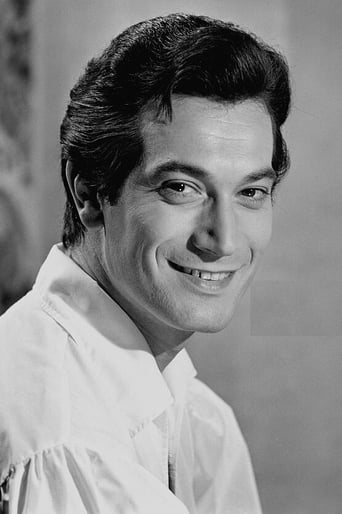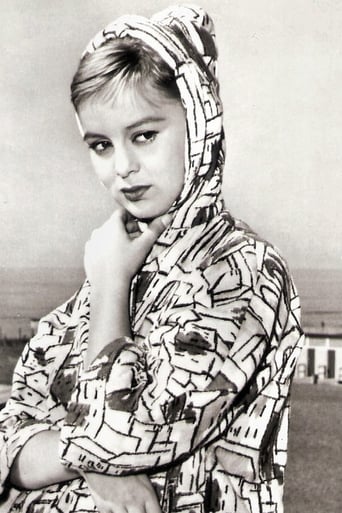Geraldine
The story, direction, characters, and writing/dialogue is akin to taking a tranquilizer shot to the neck, but everything else was so well done.
Horst in Translation ([email protected])
This is a 50-year old western movie starring Lex Barker and in the later years of his career, he actually starred in quite a few German films. There is lots of cowboy and Indian action in here, but that is a bit of a given looking at how this is adapted from a Karl May novel. It took no less than 4 writers to adapt this piece and for that, the outcome is a bit weak. The director is Robert Siodmak, actually one of Germany's more known directors in Hollywood. He also has a nomination for directing and also scored a nomination in the Foreign Language Film category. He worked with Lancaster, Gardner, de Havilland, Peck, Stanwyck and Lollobrigida to name only a few.I thought this film didn't start too bad, but I have to say the action wasn't good enough to keep me interested for 100 minutes, or even for 50 minutes. The drama is fine occasionally, but the storyline from very early with the girl and her mentor telling her who to marry completely disappears until near the end. There's a Swiss guy in here obviously for comedy reasons, but his shtick got old so quickly and soon stopped being funny. Also the way he was such a brave fighter at the end was truly unrealistic. The thing I was most disappointed with was probably the way the characters were written. There is really only good and evil, black and white, nothing in-between. No shades at all. This is really only a film for hardcore western film lovers. Everybody else should give it a pass. But if you enjoyed it, take a look at its sequel which came out only roughly 50 days after this film here.
Brian Camp
TREASURE OF THE AZTECS (1965) is a German/Italian western based on a novel by Germany's famed western novelist Karl May, whose fanciful view of the American west spawned a whole series of movies, including several starring former Tarzan (1949-53) Lex Barker, who is seen here in the role of Dr. Sternau. Barker, who was, for a time, the most popular movie star in Germany, is directed here by old Hollywood hand Robert Siodmak, well-known for a career which included such film noir classics as PHANTOM LADY, THE KILLERS, and CRISS CROSS.Set in Mexico at the time of the American Civil War, TREASURE details Dr. Sternau's efforts to obtain financial support for deposed president Benito Juarez's efforts to overthrow Emperor Maximilian, installed as Mexico's ruler by the French government. A host of characters is involved, including one of Juarez's treacherous captains (Rik Battaglia); a wealthy landowner sympathetic to Juarez's cause (Friedrich Ledebur); the landowner's wastrel son (Gerard Barray); Kara, an Aztec princess (Theresa Lorca) who holds the key to a source of Aztec wealth; a Bavarian clockmaker serving as comic relief (Ralf Wolter); and an American cowboy (American actor Kelo Henderson) assisting Dr. Sternau. Various parties are trying to get their hands on a cache of hidden Aztec gold, either for themselves or for the cause, and there is constant back-and-forth motion--battles between one faction and another, duels and fistfights, and the wastrel son's romancing of the Indian princess in a bid to learn the whereabouts of the treasure. It all culminates in a free-for-all inside a Mexican pyramid and a search for the gold inside an active volcano.Plot and characterization tend to get lost amidst all this activity and one can enjoy the Spanish and Yugoslavian landscapes where this was filmed while lamenting the lack of any reason to care too much about what happens. The film is ultimately undone by awkward fight scenes, B-movie plotting, and a sub-par English dub job. The production was originally planned as a three-hour epic, and then released in two parts, with the second installment titled PYRAMID OF THE SUN GOD (1965), with the same cast and crew. For the American release version, however, both films were compressed into one 105-minute feature, accounting for the choppy editing and continuity lapses in the print available for review. The VHS edition distributed in the U.S. also has serious soundtrack problems, with the English dub track laid down twice, but seriously out of sync so that every line of dialogue sounds like someone's off-camera repeating each line a beat later.The Indians on view look nothing like the actual Indian tribes of Mexico but are decked out in war paint and headbands adorned with feathers. When we first see them, they've got two dark-haired beauties, one of them the Aztec princess, tied to a stake, while the Indian braves dance around in a circle. Sternau and his party of three come and rescue the women from dozens of braves without suffering a scratch.As a German/Italian western directed by a German director who'd excelled in Hollywood, with a French/Italian/Spanish/German cast headed by an American star and shot in Spain and Yugoslavia, it is not without interest for those Euro-cult fans curious about such hybrids. It's got an odd tone about it, not quite stylized enough to compare with Italian westerns, but a bit too cartoonish to be taken seriously as a western. It's probably closer in spirit to the cliffhanger serials of old than to any classic westerns. This is particularly evident in the preposterous, but action-packed finale. The bombastic music score deliberately recalls certain well-known Hollywood western scores.Of special note is the participation of Hollywood actor Jeff Corey in the role of President Abraham Lincoln in a brief scene with Dr. Sternau at the beginning. Corey had worked for Siodmak back in 1946 in THE KILLERS. Neither Corey nor Barker dub their own voices on the English track. Barker had previously worked for Siodmak in the German-produced THE SHOOT (1964). Fausto Tozzi plays Benito Juarez and offers a striking resemblance to the great Mexican leader.






